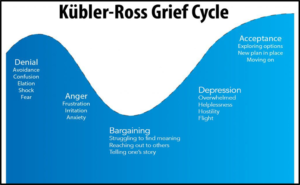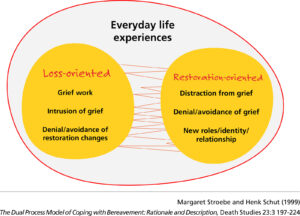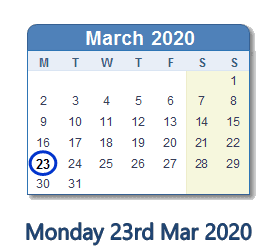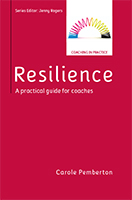
It is being called the turnover tsunami: the evidence that faced with returning to work people are looking for new roles in unprecedented numbers,. This is more than the annual reflection that often takes place when people go on holiday. It is an indication that the demands that the past 18 months have impacted on how people see their work and the organisations they work for. Something has been lost and they hope it will be restored by moving on. The word grief has been used to describe the sense that COVID has changed not just many personal lives, but also work lifes.
Death has been brought to the front of our minds because a global experience has impacted on every community. Loss has become more than a personal experience it is a community experience. The word grief describes not just the individual pain of losing a person we love, of time with loved ones, of what we once accepted as normality, and now the word is being used to describe what people may feel in returning to the workplace. That grief may be for the ending of the life that has been created during lockdowns. It may also be for the recognition that the workplace is changed.
Personal Grief
When we grieve we are acknowledging the loss of what we valued. When we grieve for an individual we are recognising what about them was important to us. To get through that process and be able to create a different life requires that we adjust and move forward accepting that change. Both of those truths are difficult and our instinct is to resist: to yearn for what has gone, to be angry at the unfairness of what has happened, or to numb ourselves so that we feel nothing as a form of self protection. We may even as Joan Didion wrote in ‘The Year of Magical Thinking’ imagine that nothing has changed, that the person is still there just waiting to reappear, and that the death has not really happened.
All of those personal reactions to the loss of someone we care for can be played out again in how we see the organisation that is emerging as we move through COVID.
- A sadness and yearning for how things were before we knew the word COVID.
- An anger at the organisation for what it has done in response to COVID which changes what we do, where and with whom.
- A numbness towards work that leads to disengagement.
- A denial that anything has changed in the hope things will return to how they were
In any major change in our lives there is loss, so looking to what we know about the grieving process can be helpful in the context of work as well as in our personal lives.
What does grieving mean in a work context
It would be easy to look towards the Elizabeth Kubler Ross model of the stages of grief, because it has been used so many times as a change model, but the model has limitations.

- It was never intended to be seen as stages that people have to go through sequentially, but it often is interpreted that way.
- It was based on research on those who were dying, not the responses of those who lived after them. Neither was it designed for change in an organisational setting.
- Many people don’t recognise themselves in the stages and sometimes feel angry at the sense that they are only doing grief properly if they follow stages.
More helpful to looking at grief in an organisational context is the dual-process model.

This model captures the process that we live on a daily basis. Humans oscillate. We oscillate between breathing in and out, between rest and wakefulness, between the desire for stability and the desire for adventure. Looking at grief as a necessary process of oscillation means:
- Allowing for sadness
- Ensuring that there is also a focus on restoration and of creating something new.
What does this mean in a work setting?
- Acknowledging the changes that people are finding difficult. Grief is an internal process of sadness that leads to self reflection and over time a resetting. It is also externalised in being able to talk about what has been lost. Going back into the workplace, it is going to be important to allow for talking about what people are experiencing as loss, as an important part of being able to adjust to what now is.
- Grieving also encompasses mourning: the visible rituals that allow us to mark loss. What is it important to visibly acknowledge in returning to work? What rituals are needed?
- Restoration means encouraging people to do new things. Just as repeating the living patterns that once marked a person’s life with their loved one can reinforce a sense of loss, encouraging people to do different and new things can help recovery. Focus on helping people to see value in doing things differently. It is in doing something different that people create the flexibility that is the marker of resilience. Working life will be different, but within that there will be things that were not possible under the old ‘norms’. Helping people to experiment with the new is an important part of moving forward.
What will help recovery?
Richard Bonnano, Professor of Clinical Psychology at Columbia University has spent his career studying bereavement and his concludes from many studies that the marker of grief is that most of us are resilient. Most people work through what is a difficult process and do live satisfying lives. What helps that process is:
- Behavioural flexibility ie being able to adjust the changed reality.
- An optimistic outlook that things will work out OK
- Confidence in being able to control outcomes
- More behaviours in our repertoire e.g. can express sadness but can also recognise when it is best not to express that sadness.
- Being able to identify benefits g. I have discovered I am strong, I never thought I could do . . . without . . . and I have learnt that I can.
And there is one additional factor that emerged from the work of Elizabeth Kubler Ross’s collaborator David Kessler: the importance of creating personal meaning from the loss of that person, so that the person stays with you, even though they are no longer physically present.
Apply that to organisations and it means:
- The organisation being able to adjust to the changed reality of how work can now be done.
- Signalling an optimism that difficulties can be worked through.
- Showing confidence in the future as within the organisation’s control.
- Responsiveness to the differences in people’s attitudes as they return to the workplace – rather than rigid policies.
- Highlighting the benefits that have emerged from being forced to think differently about business is done.
- Building into discussions with individuals the purpose and meaning of what they now want from their work.
Talking about grief in organisations, may feel like a diminution of the enormity of what envelops us when someone we care for dies, but there is much that organisations can learn from grief work to help the transition back into a workplace that has been forever changed by COVID.
References:
George Bonnano, The Other Side of Sadness: what the new science of bereavement tells us about life after loss, 2009, Bantam.
Joan Didion, The Year of Magical Thinking, 2006, Harper Perennial.
David Kessler, Finding Meaning: the sixth stage of grief, 2019, Rider.
Elizabeth Kubler Ross and David Kessler, On Grief and Grieving, 2014, Simon and Schuster.
Stroebe, M.S and Schut, H.A.W., The dual process model of coping with bereavement: Overview and update, 2001, Death studies, 23, 197-224.

 It was March 23rd when the UK government put the country into its Stay Home lockdown. The day when we discovered the word ‘furlough’, and moved our social interactions into a world of multiple faces on screens. What was once the plot line of a dystopian novel became our way of living. Four months on as lockdown lurches into an uneven, confused reopening it is a good time to take stock of how your resilience is holding up.
It was March 23rd when the UK government put the country into its Stay Home lockdown. The day when we discovered the word ‘furlough’, and moved our social interactions into a world of multiple faces on screens. What was once the plot line of a dystopian novel became our way of living. Four months on as lockdown lurches into an uneven, confused reopening it is a good time to take stock of how your resilience is holding up. Remember Brexit? A year ago I wrote a blog linking the uncertainty of Brexit with the need to be resilient. Where once Brexit dominated our media, now it does not merit a newspaper column inch. Its’ place has been taken by a word unknown to us all until 2020 – COVID 19. In 2019 I wrote about VUCA: a term then increasingly familiar in business contexts, because it captured the sense of Volatility, Uncertainty, Complexity and Ambiguity that many people felt in their workplace as Brexit loomed. Little did we know that a year on, we would be living with VUCA on steroids.
Remember Brexit? A year ago I wrote a blog linking the uncertainty of Brexit with the need to be resilient. Where once Brexit dominated our media, now it does not merit a newspaper column inch. Its’ place has been taken by a word unknown to us all until 2020 – COVID 19. In 2019 I wrote about VUCA: a term then increasingly familiar in business contexts, because it captured the sense of Volatility, Uncertainty, Complexity and Ambiguity that many people felt in their workplace as Brexit loomed. Little did we know that a year on, we would be living with VUCA on steroids.

